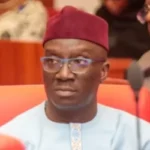The event took place on Thursday last week in the splendid Legend Hotel situated within the precincts of the Murtala Mohammed Airport, Lagos. The Forum coming just a few weeks after the Nigerian Deposit Insurance Corporation (NDIC) had celebrated its 30th year anniversary provided a good opportunity to raise the veil over many issues that might seem opaque to the reading public. Banking and financial matters are things that affect our readers, day in day out and any opportunity meeting face to face with one of the main regulators is a chance to grab some answers to some recurring questions.
Actually one thing that could be conceded to the management of the NDIC is that in the past few years they have been indefatigable on hitting the road to engage with and explain issues to a variety of stakeholders. They have just had a sensitization workshop with the judges of states and FCT high courts. They have had this kind of engagement with them for some years now and it always provided an opportunity to explain emerging issues to the judiciary and seek their cooperation as arbiters thus ensuring speedy resolution of disputes that usually came before them. Last Thursday was the turn of media.
It was inevitable that the Forum would start with an overview of the 30 years of NDIC. This we got in ample proportions from Dr S. A. Oluyemi, NDIC’s Director of Communication and Public Affairs Department, who chronicled the life of the corporation from its birth in 1989. The NDIC, he told us arrived on the scene at the right time as a child of necessity. In the late 1980s the Nigerian economy was being deregulated and a key aspect was also the liberalization of banking licences. NDIC arrived on the scene via Act 22 of 1988 (now repealed and replaced with NDIC Act no 16 of 2006), working closely with the Central Bank of Nigeria (CBN) to effectively cover and supervise the banks so as to protect depositors’ monies and help forestall systemic failures.
It was effectively midwifed by the CBN – the first and second Managing Directors were staff of the CBN and also for the three first years of operation the CBN Governor served as chairman of the NDIC board of Directors. Many of the staff came from the CBN, others from other Federal establishment and many others from the higher rungs of the state governments’ services. Over the years the corporation has been able to maintain a highly motivated and well-trained staff to keep up with the changing circumstances of effectively covering and supervising the ever increasing number of banks.
The NDIC in its 30 years of operation weathered many storms starting with the massive bank failures of the 1990s, followed in the years of the millennium the issues that arose from the bank consolidation exercises. All were resolved satisfactorily and lessons learnt made the NDIC look for solutions that further improved its operations. The NDIC Act was repealed and replaced twice to reflect changing circumstances and is even today before the National Assembly for further improvements. The second presentation by Mrs O O Adeyinka, Deputy Director, Bank Examination Department, consolidated on Dr Oluyemi’s presentation though emphasising on the emerging issues in the regulation and supervision of banks in the country. As our banks grew over time with changing capital base, owners and shareholders, the NDIC among other regulators had to change ways of regulation and coverage. Mrs Adeyinka explained how and why at a stage the NDIC takes over banks overnight and why it always had to be done surreptitiously.
Dr Kabir S. Katata, Deputy Director Research, Policy and International Relations Department, talked about the exciting world of technology as it rapidly affects finance. The adoption of new technology in Nigerian Banks has advanced so much that many operations that are taken for granted now could not be contemplated a few years ago. On the global front it is obvious that companies that are digitally based have taken over the front seats from the tradition high fliers. Thus GE, Exxon, Citi and Walmart who were leading at the turn of the century in the US have now been replaced with Microsoft, Amazon Apple and Facebook. Here it is obvious that the banks that digitalized early have gone far ahead. In fact, Dr Katata envisages that branch banking as we know it today will disappear as every activity in the bank becomes digital.
The sad takeaway from his presentation was the realization that most of the applications used in our banking operations are developed and built elsewhere particularly India and China but deployed widely here. We are yet to develop the capacity to build them ourselves. And this is a multibillion dollar business which our local investors must key into for the overall industry to grow.
Many questions came up after these presentations and I am sure readers have harboured these queries in their minds too. Why did Diamond Bank become Access Bank? Who named Sky Bank, Polaris? Why is it that the change is always done in a clandestine manner? How does NIDC find the money to pay off depositors when a bank fails? The questions just poured out. Fortunately, the NDIC management staff among us were always ready to shed light on these, and other, queries that arose.
Actually one of the most nagging questions had been the one associated with the bridge banks that took over some troubled banks recently. Bridge banking is one of the most visible and enduring successes of the regulators in the past few years as one the most effective resolutions applied to terminal bank failures and yet it seems to be one of the most misunderstood even by those who should know. A bridge bank is a shell entity that NDIC is allowed by law to incorporate and keep under wraps to be used to take over a dying bank that had been wrecked by bad loans and or bad management by the owners. This is done with the best intentions to safeguard deposits of hapless citizens and jobs of the bank workers and more crucially avoid systemic failures in the industry.
The regulators would take over the bank in what would look like a cloak and dagger operation in the dead of the night and in the morning the public would only see the new name of the bank along with a new management and board of directors. However, when one entered the banking hall one would be surprised to find the same faces attending to him. The work in the bank would seem to go on seamlessly even though for all practical purposes the bank was bankrupt. What had happened at night in the bank was that the regulators have taken over the liabilities of the bank, including the bad loans and shored up its capital base, allowing smooth and continuous transactions.
Eventually and with better management under the eagle eyes of the CBN and NDIC, the new managers would turn the bank around and sell it to whoever would make the best bid. Those who run the bank aground would be prosecuted and government would recoup its money from the sales of the newly rejuvenated bank. Readers will agree with me that this is a win-win situation. This is what the banking sector has been experiencing since when the first batch of bridge banks were rolled out, i.e. Mainstream Bank to take over Afri Bank, Keystone Bank to take over Bank PHB and Enterprise Bank to take over Spring Bank. Lately Sky Bank which suffered the same fate became Polaris Bank overnight.

 Join Daily Trust WhatsApp Community For Quick Access To News and Happenings Around You.
Join Daily Trust WhatsApp Community For Quick Access To News and Happenings Around You.


